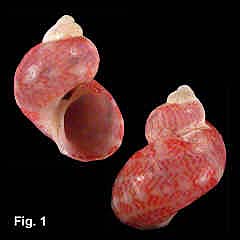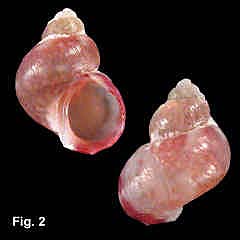|
|
|
|
|
Tricolia variabilis (Pease, 1861) Description: Shell light to heavy in weight, transparent or opaque, moderately squat to moderately tall, whorls rounded or somewhat angled. Protoconch smooth or with faint spiral striae, teleoconch smooth except for a few very fine spiral threads above suture (usually not visible due to erosion). Aperture nearly round, outer lip thin to thick, flared in males. Umbilicus a narrow to wide chink. Operculum corneous internally, calcareous externally, white, convex. Background colour white, pink, orange, amber, brown, yellow or grey, with a great variety of colour patterns. NSW shells often have reddish-brown axial zigzag lines, many or few, narrow or broad, closely or widely spaced, sometimes gathered together into axial bands; or white flames descending from sutures, or spiral bands of white patches. Size: Female up to 5.2 mm, male up to 3.3 mm; in NSW, female up to 3.8 mm, male up to 3.0 mm (Robertson, 1985). Distribution: Indo-West Pacific; in Australia, Perth, WA, to Green Cape, NSW. Habitat: Lives on algae in the intertidal and shallow subtidal region, down to about 20 m. Common to abundant. Comparison: See T. rosea. Synonyny: There are many synonyms. Those relevant to NSW are Eutropia virgo Angas, 1867 and Phasianella gregaria Laseron, 1955. Remarks: This seems to be one of the most variable of all gastropod species. Shells and radula are sexually dimorphic, with mature males being smaller, and having a flared outer lip and larger aperture. In Hawaii, the species lives on a brown alga in the intertidal zone and shallow subtidal, probably not feeding on the alga itself, but on the detritus and epiphytic microscopic algae thereon. Males sit on the shell of the female during the breeding season, and when separated, pair up with the same partner again. Eggs are laid in a gelatinous egg mass and juvenile crawling animals emerge, without a planktonic larval stage (Robertson, 1985). Fig. 1 Kurnell, NSW. Female shell. (DLB unregistered) Fig. 2 Bittangabee, north of Green Cape, NSW. Male shell. (C.115379) |

